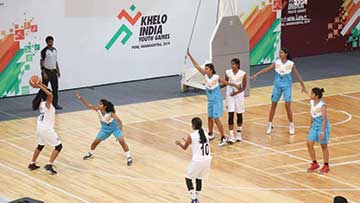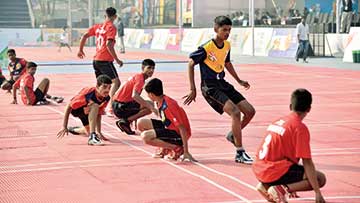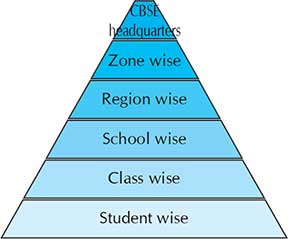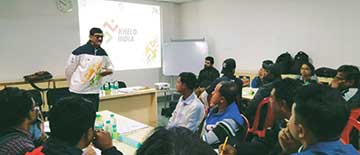Arnab Bhattacharjee
Now that we all have seen the ‘Paanch minute aur’ commercial on the small screen, we are familiar with the name – ‘Khelo India’.
India’s Minister of State for Ministry of Youth Affairs and Sports and Olympic medal winner Rajyavardhan Singh Rathore fondly remembered his childhood during the launch of the Khelo India programme. Addressing the nation on a social media platform, he said, “in our childhood when we used to play, that was the exact time when our parents would remind us of our homework. And we would say ‘just five more minutes. There was no one to speak for us then but now we have a voice. So why don’t we all speak up for all the kids in the country and say ‘let them play’, five minutes more, play India.” This phrase changed the lives of some children if not all and bureaucrats thought that may be one day this nation too will also be addressed as a ‘sporting country’.
What is ‘Khelo India?’
 Introduced in 2018, the Khelo India Programme aims to revive the sports culture at the grassroot level, by building a strong framework for all sports played in our country and establishing India as a great sporting nation. It is a joint effort by the Sports Authority of India (SAI) and Central Board of Secondary Education (CBSE). The motto of this programme is to offer an opportunity to each and every school going child to play the sport they like. Initially, it has begun with CBSE schools with plans of incorporating other boards in the near future. Khelo India’s target is to reach 30 crore school going children and in the upcoming seven years, it plans to spread to one and a half million children in 707 districts in 29 States and seven Union Territories. The CBSE has made HPE (Health and Physical Education) compulsory in their academic curriculum, the purpose being academic education inside the classroom and games beyond the four walls.
Introduced in 2018, the Khelo India Programme aims to revive the sports culture at the grassroot level, by building a strong framework for all sports played in our country and establishing India as a great sporting nation. It is a joint effort by the Sports Authority of India (SAI) and Central Board of Secondary Education (CBSE). The motto of this programme is to offer an opportunity to each and every school going child to play the sport they like. Initially, it has begun with CBSE schools with plans of incorporating other boards in the near future. Khelo India’s target is to reach 30 crore school going children and in the upcoming seven years, it plans to spread to one and a half million children in 707 districts in 29 States and seven Union Territories. The CBSE has made HPE (Health and Physical Education) compulsory in their academic curriculum, the purpose being academic education inside the classroom and games beyond the four walls.
The importance of the programme:
• Development of playgrounds
• Community coaching development
• Annual sports competition
• Talent search and development
• Utilization and upgradation of sports infrastructure
• Sports for women
• Physical fitness of school children
• Promotion of rural and indigenous/tribal games
• Every child’s health will improve which in turn will make a healthier nation
The philosophy of the programme:
• Maximum participation
• Success for every child
• Understanding of human movement
• Understanding of one’s own potential
 When Khelo India flagshipped its first edition, its aim was to revive the sports culture in India at the grassroot level by building a strong framework for all sports played in our country. Now after two years, things have not happened the way they should have. For this kind of novel initiative, the governing committee should look beyond elite athletes who have already been identified by federations and are competing at the national or even the international stage.
When Khelo India flagshipped its first edition, its aim was to revive the sports culture in India at the grassroot level by building a strong framework for all sports played in our country. Now after two years, things have not happened the way they should have. For this kind of novel initiative, the governing committee should look beyond elite athletes who have already been identified by federations and are competing at the national or even the international stage.
As school educators and master trainers, we have realized that the games have been nothing more than a national-level invitational meet for under-17 and under-21 athletes who have already been making a mark for the last couple of years and are just getting a bigger platform in terms of visibility. However, the real need of the hour is to have far reaching impacts across schools by creating a pyramid structure which spots raw talent and then helps them level-up.
Quickly, it was realized that in order for Khelo India to achieve its stated goal, the focus has to shift from being an inter-state invitational competition to a truly inter-school, inter-university competition by merging the School Games Federation of India (SGFI) and All India Universities (AIU) competitions.
In this manner, the schools, colleges and universities will become equal partners in the programme, thereby encouraging them to invest in sports infrastructure and development of players, something the current structure of SGFI and AIU has failed to achieve. A very pertinent point raised during a recent Khelo India Master training summit was that the programme needs to look at coaching at the grassroots. According to the current structure of the programme, a scholarship is offered to around 1500 athletes following the first Khelo India School Games in New Delhi; the selected athletes are required to join the Khelo India accredited academies to avail the benefits of the program. But doubt looms over the programme because most of the schools with better infrastructure and big-name coaches can project an athlete from a potential talent to an international medallist, without the help of this programme. But one must not forget that most of the talent in India is identified and nurtured at the grassroot level by individual coaches with little or no infrastructure support.
How does Khelo India work?
There is a combination of health and physical education in all the khelo India programmes with few motor fitness tests for three different age groups which are designed by SAI.
Age group 5-8 years / classes 1-3
• Body composition (BMI)
• Co-ordination (Plate tapping)
• Balance Test (Flamingo balance)
Age group 9-14 years / classes 4-8
• Body composition (BMI)
• Strength test
a) abdominal strength (partial curl up)
b) Muscular endurance (Push ups for boys – modified push ups for girls)
c) Flexibility (Sit and reach test)
d) Cardiovascular endurance (600 metres run)
e) Speed test (50 metres dash)
Age group 15-18 years / classes 9-12
• Body composition (BMI)
• Strength test
a) abdominal strength (partial curl up)
b) Muscular endurance (Push ups for boys – modified push ups for girls)
c) Flexibility (Sit and reach test)
d) Cardiovascular endurance (600 metres run)
e) Speed test (50 metres dash)
It is compulsory for every student of the school, especially those under CBSE, to undergo these tests and the data is updated regularly on the school and CBSE board’s software. From there, the CBSE board officials will select deserving candidates for further training at SAI.
Monitoring and tracking
 It has been planned that the fitness data will be dissected in the following manner for identifying the fittest children, fittest school and fittest region.
It has been planned that the fitness data will be dissected in the following manner for identifying the fittest children, fittest school and fittest region.
With the help of all this data, one can create a national benchmark over a period of time from 30 crore school-going children and 8 crore school dropouts aged between 5 and 18 years. This is also beneficial for the 3.5 crore families getting positively influenced into leading a healthy lifestyle and imbibing respect for sports and life skills.
Activities involved in the primary and secondary section of the CBSE schools:
Primary:
• Making students, teachers and parents aware of the importance of good health and fitness.
• Encouraging 60 minutes of play every day.
• Making physical activity a part of the learning process.
Secondary:
• Identifying and nurturing talents from an early age.
• Motivating potential and outstanding performers in various games and sports for excellence.
 In these few months, since the programme was launched, I have realized that it is not going to be an easy job. India is a nation where parents still give more importance to academics relative to physical education. Schools have to cope with a huge academic curriculum alongside other activities. But the ray of hope will remain – the wish to see raw talent nurtured into reputed sports professionals.
In these few months, since the programme was launched, I have realized that it is not going to be an easy job. India is a nation where parents still give more importance to academics relative to physical education. Schools have to cope with a huge academic curriculum alongside other activities. But the ray of hope will remain – the wish to see raw talent nurtured into reputed sports professionals.
The Central Government of India along with SAI and CBSE is putting in its best efforts to bring about a change in the way people look at sports in the country today. Celebrities have been roped in to promote the good effects of having a healthy lifestyle. Keeping our fingers crossed, let us just pray for the success of this initiative and till then we can rightly scream and say – “hum fit, toh India fit!”
The author is the Head of Department, Physical Education, at Lakshmipat Singhania Academy, Kolkata and a Master Trainer at Khelo India National Fitness Assessment Programme. He can be reached at arnabbhattacharjee1966@gmail.com.
